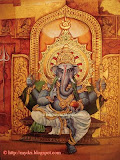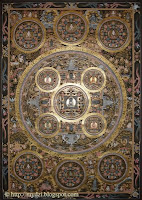
Wishing you and your family a very Happy New Year, Hope you have a great year ahead.
Happy New Year 2010
 The swastika,
The swastika, Swastika is an ancient symbol, and found worldwide. It is a sacred and prehistoric symbol that predates all formal religions known to humankind. Hindu and Buddhist rank Swastika second only to OM.
Swastika is an ancient symbol, and found worldwide. It is a sacred and prehistoric symbol that predates all formal religions known to humankind. Hindu and Buddhist rank Swastika second only to OM. In Hinduism and Buddhism many gods and goddess holding Swastika (See left Ganesha picture, click to enlarge). Swastika can be seen in the art of the Egyptians, Romans, Greeks, Celts, Native Americans, and Persians as well Hindus, Jain and Buddhists.
Below is a chart that display swastika used in different religion.
In Hinduism and Buddhism many gods and goddess holding Swastika (See left Ganesha picture, click to enlarge). Swastika can be seen in the art of the Egyptians, Romans, Greeks, Celts, Native Americans, and Persians as well Hindus, Jain and Buddhists.
Below is a chart that display swastika used in different religion.
 Tibetan prayer flags or wind horse are square in shape, and traditionally printed in the color sequence of the five Buddha families; blue, white, yellow, red and green. These colors also represent the elements: earth (Yellow), water (Green), fire (Red), air/cloud (White), sky /space (Blue).
Tibetan prayer flags or wind horse are square in shape, and traditionally printed in the color sequence of the five Buddha families; blue, white, yellow, red and green. These colors also represent the elements: earth (Yellow), water (Green), fire (Red), air/cloud (White), sky /space (Blue).




 Good News! You are going to read a blog post about Himalayan Arts Exhibition but venue is not in Bangkok and also not by us. See Previous Post about Tibetan Exhibition in Bangkok by Tibet Arts Gallery. Carlton Rochell Asian Art brings you the Exhibition MASTERPIECES OF HIMALAYAN ARTS since September 11 to 25, 2009. This exhibition is held in the Fuller Building, a New York City. Even though this exhibition is held in New york. we can enjoy this exhibition by view Online catalogue for this exhibition. I got this link in my email, which i would like to share with you.
Good News! You are going to read a blog post about Himalayan Arts Exhibition but venue is not in Bangkok and also not by us. See Previous Post about Tibetan Exhibition in Bangkok by Tibet Arts Gallery. Carlton Rochell Asian Art brings you the Exhibition MASTERPIECES OF HIMALAYAN ARTS since September 11 to 25, 2009. This exhibition is held in the Fuller Building, a New York City. Even though this exhibition is held in New york. we can enjoy this exhibition by view Online catalogue for this exhibition. I got this link in my email, which i would like to share with you. Karmapa Lama
Karmapa Lama This is an old Thanka painting of Green Tara, painted in Newari style. Green Tara is represented seated on a lotus-throne, the right leg pendant, with the foot supported by a small lotus, the stem of which is attached to the lotus throne. She is slender, graceful in her pose, and dressed like a Bodhisattva and wears the five-leafed crown. These leaves of crown symbolize five Dhyani-Buddhas.
This is an old Thanka painting of Green Tara, painted in Newari style. Green Tara is represented seated on a lotus-throne, the right leg pendant, with the foot supported by a small lotus, the stem of which is attached to the lotus throne. She is slender, graceful in her pose, and dressed like a Bodhisattva and wears the five-leafed crown. These leaves of crown symbolize five Dhyani-Buddhas. Some time in her crown, the five Dhyani-Buddhas are figured.
Some time in her crown, the five Dhyani-Buddhas are figured.
 Green Tara is represented seated on a lotus-throne, the right leg pendant, with the foot supported by a small lotus, which symbolize she is free from samsara – through her practice and attainments. She is ready to help for her practitioner. Green tara is very immediate and quick. One calls to her for immediate assistance, and also often for help with worldly things like lover, wealth and so on, as well as spiritual things.
Green Tara is represented seated on a lotus-throne, the right leg pendant, with the foot supported by a small lotus, which symbolize she is free from samsara – through her practice and attainments. She is ready to help for her practitioner. Green tara is very immediate and quick. One calls to her for immediate assistance, and also often for help with worldly things like lover, wealth and so on, as well as spiritual things. There is a Sanskrit name for Ganesha is Ekadanta (right picture) or one tusk Ganapati, read 32 forms of Ganesha. Some of the earliest icons show him handling his broken tusk. We can find many stories about how Ganesha lost his one tusk. In this post you will read three story behind it.
There is a Sanskrit name for Ganesha is Ekadanta (right picture) or one tusk Ganapati, read 32 forms of Ganesha. Some of the earliest icons show him handling his broken tusk. We can find many stories about how Ganesha lost his one tusk. In this post you will read three story behind it. A different legend narrates that Ganesha was asked to scribe down the epic of Mahabharata, dictated to him by its author, sage Vyasa. Taking into note the enormity and significance of the task, Ganesha realized the inadequacy of any ordinary 'pen' to undertake the task. He thus broke one of his own tusk and made a pen out of it. The lesson offered here is that no sacrifice is big enough in the pursuit of knowledge." In Some Ganesha Image, the broken tusk that Ganesha holds like a pen in his lower right hand is a symbol of sacrifice, which he broke for writing the Mahabharata.
A different legend narrates that Ganesha was asked to scribe down the epic of Mahabharata, dictated to him by its author, sage Vyasa. Taking into note the enormity and significance of the task, Ganesha realized the inadequacy of any ordinary 'pen' to undertake the task. He thus broke one of his own tusk and made a pen out of it. The lesson offered here is that no sacrifice is big enough in the pursuit of knowledge." In Some Ganesha Image, the broken tusk that Ganesha holds like a pen in his lower right hand is a symbol of sacrifice, which he broke for writing the Mahabharata. Another Story I found in the web is from Ganesha Chaturthi (the birth day of Lord Ganesha), which tells a third story:
Another Story I found in the web is from Ganesha Chaturthi (the birth day of Lord Ganesha), which tells a third story: If you visit this blog regularly you may have notice with some deities’s statues or thanka paintings, which is in terrifying or wrathful forms. Wrathful deities looks terrified, hideous and hair raising and different then other Buddhist ideals. But They are not personifications of evil or demonic forces. Wrathful deities are kindly gods who symbolize the tremendous effort it takes to vanquish evil, the violence that is a fundamental reality of the cosmos and the human mind and protect the faithful by instilling terror in evil spirits. In Sanskrit, the wrathful deities are known as Dharmapalas, which means "Dharma Protector".
If you visit this blog regularly you may have notice with some deities’s statues or thanka paintings, which is in terrifying or wrathful forms. Wrathful deities looks terrified, hideous and hair raising and different then other Buddhist ideals. But They are not personifications of evil or demonic forces. Wrathful deities are kindly gods who symbolize the tremendous effort it takes to vanquish evil, the violence that is a fundamental reality of the cosmos and the human mind and protect the faithful by instilling terror in evil spirits. In Sanskrit, the wrathful deities are known as Dharmapalas, which means "Dharma Protector".
 Mahakala is one of the eight dharmapala of the Buddhist pantheon. Mahakala's name translates as the "Great Black," one, or "Great time." The latter is a reference to the deity's ability to transcend all time. In Tibet we can found more then seventy five manifestations of Mahakala. As dharma protector, images of the wrathful deities are given a good position at the entrance doors of home and Buddhist Shrines.
Mahakala is one of the eight dharmapala of the Buddhist pantheon. Mahakala's name translates as the "Great Black," one, or "Great time." The latter is a reference to the deity's ability to transcend all time. In Tibet we can found more then seventy five manifestations of Mahakala. As dharma protector, images of the wrathful deities are given a good position at the entrance doors of home and Buddhist Shrines.





















